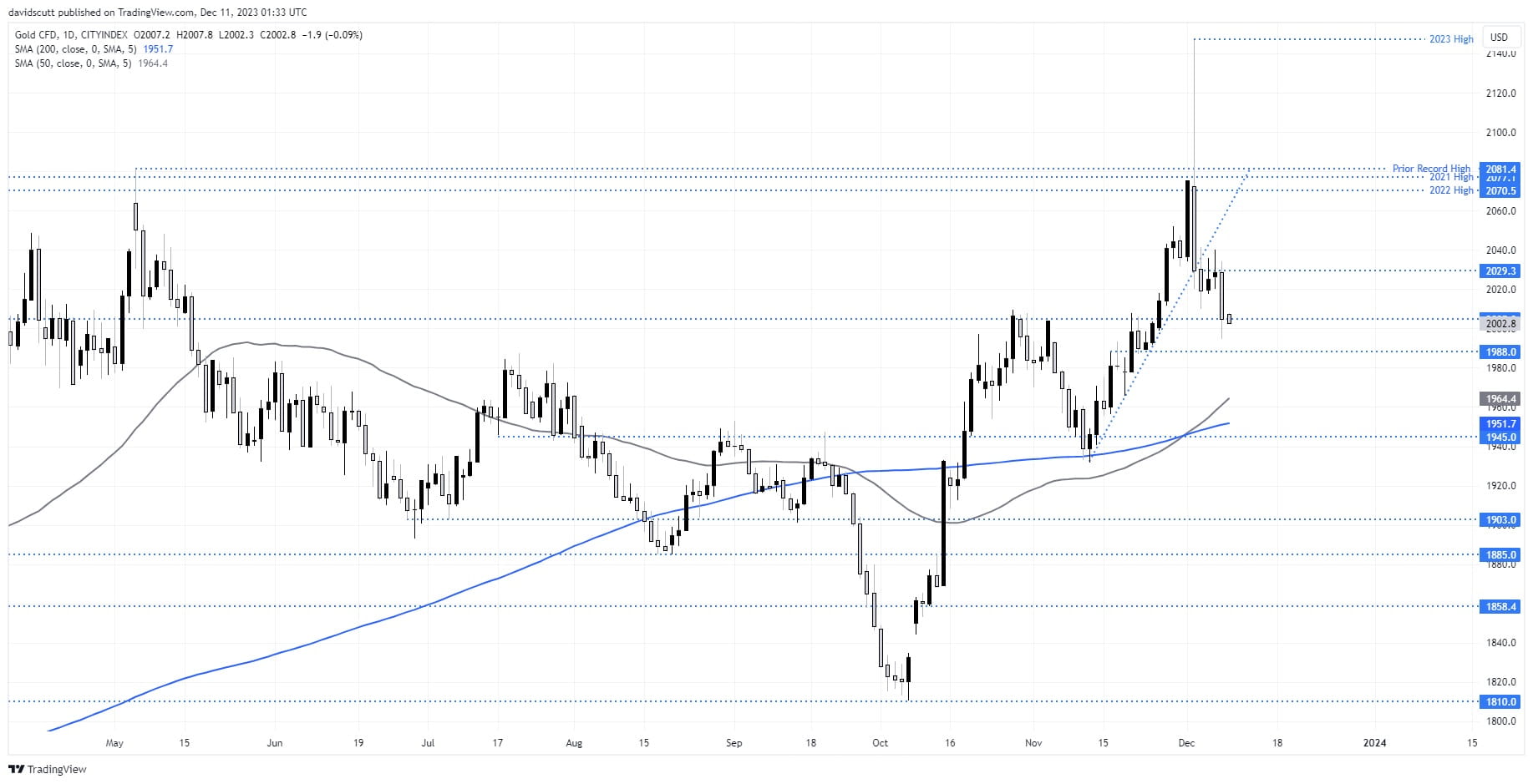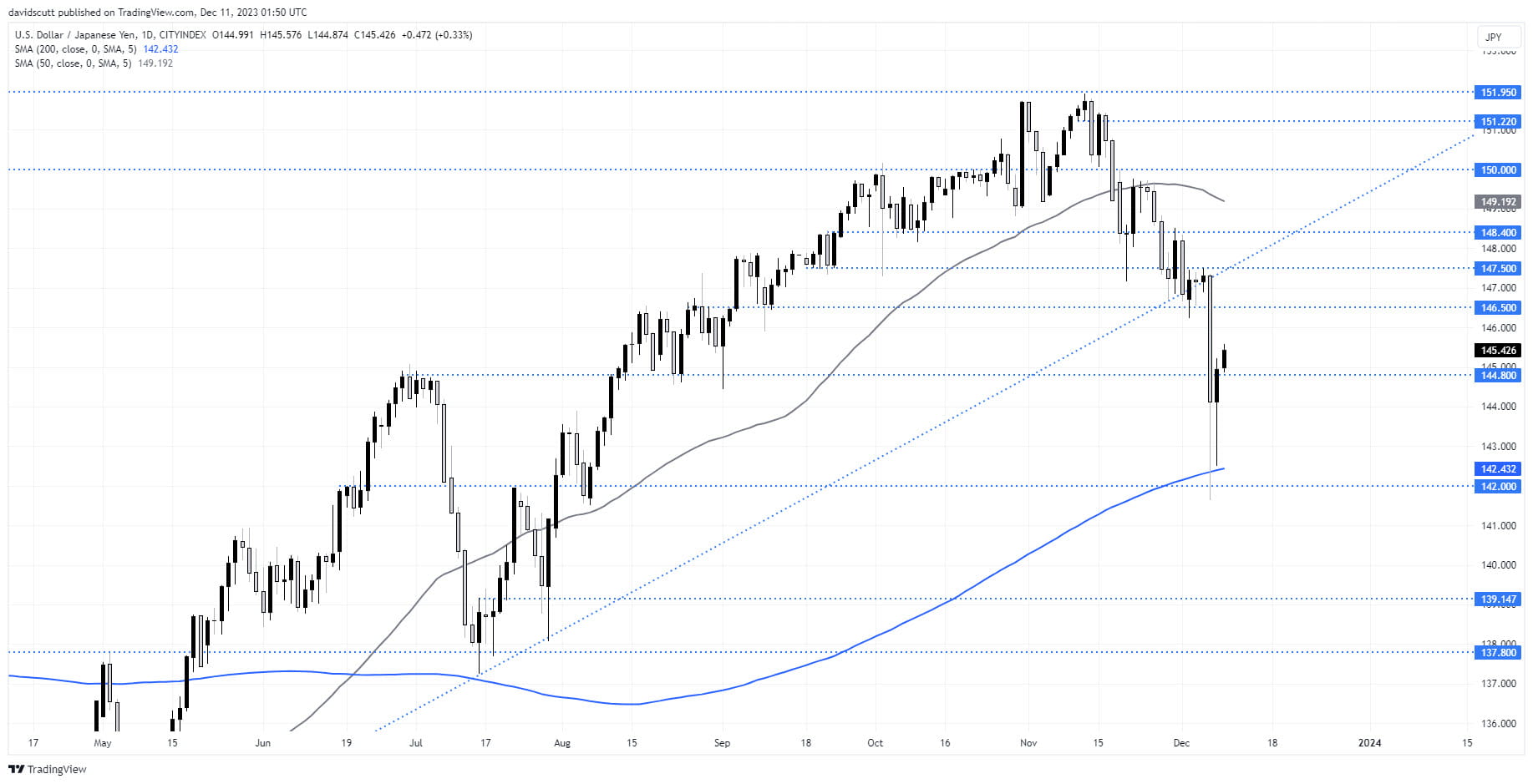• The US macro calendar is full of risk events this week with the Fed rate decision, US CPI and Two long bond auctions arriving over the next few days. Gold and USD/JPY are two markets particularly sensitive to shifts in US interest rates.
By :David Scutt, Market Analyst
- The US macro calendar is full of risk events this week with the Fed rate decision, US CPI and Two long bond auctions arriving over the next few days
- After recent moves reflecting growing expectations for rate cuts next year, anything that pushes back against the dovish narrative could easily generate upside for the USD
- Gold and USD/JPY are two markets particularly sensitive to shifts in US interest rates
The soft-landing narrative that’s been accompanied by growing monetary policy easing expectations faces a series of big tests this week with rate decisions from the Fed, ECB and BoE, long bond auctions in the US and Japan, US consumer price inflation along with flash PMIs. Except for the latter, risks are skewed towards higher yields following recent market moves, creating an environment which may be positive for the US dollar. Entering what’s traditionally a strong period for riskier asset classes on the back of declining market liquidity, that amplifies the risk we could see extremely whippy price action across the risk asset spectrum.
Hawkish Fed risk is elevated
While it’s a busy macro week, one event stands out above all others: the Federal Reserve’s FOMC policy decision on Wednesday. Including updated economic projections, it could set the tone for other central bank meetings in the subsequent days. With traders flirting between the idea of four or five rate cuts next year, it’s not difficult to see the risk of Fed officials providing a rates outlook far less dovish than what markets expect.
Looking back three months when the prior economic and rates projections were released, FOMC members forecast another rate hike in 2023 and = two rate cuts for 2024. With little chance the Fed will deliver on that 2023 hike at this meeting, and with financial conditions far looser now than they were then, will the Fed want to validate aggressive easing expectations that have been priced in by markets? Sure, there has been progress in bringing underlying inflation towards target, and the pace of job creation is slowing, but the unemployment rate is only 3.7% with wages growth continuing to motor along at a decent clip. It’s extremely doubtful.
New dot plot may forecast only one cut for 2024
Rather than the median economist forecast for two cuts and market pricing for four or more, it would not surprise to see the Fed forecast only one cut for 2024 in its updated funds rate dot plot. To indicate more would be ignorant of the significant easing in financial conditions which has been seen since the FOMC last met, especially after the Fed cited the preceding tightening in financial conditions as a factor likely to reduce inflation in its November policy statement.
Don’t rule out a change to commentary towards financial conditions
While not extremely likely, there’s also a risk the Fed may remove its reference to financial conditions altogether from its statement, a move that would signify an attempt to take back control of the outlook for rates after passing off the job of finishing the inflation fight to markets in the runup to its November meeting.
US debt auctions, falling yields to test buyer demand
Potentially adding to upside risks for US yields, the US Treasury will hold a series of bond auctions that will provide a test for demand after the significant decline in yields since the start of November. Three and 10-year note auctions will be held Monday with a 30-year bond offer going off 24 hours later. For context, yields on existing 10 and 30-year debt have fallen more than 70 basis points from the recent highs. Combined with the risk of the Fed being far less dovish than markets expect, buyer demand could easily disappoint, especially with the US fiscal trajectory anything but solved.
With the ECB and BoE also likely to push back against building easing expectations, even if not likely to be regarded as realistic by some traders, it puts the emphasis on the US November core CPI print to limit the potential upside for US yields and dollar this week.
Anything that suggests inflation may settle at an annualised pace above the Fed’s 2% target will surely raise questions over market pricing for large-scale rate cuts next year. The median economist forecast looks for a increase in core inflation of 0.3%. While better than those seen in 2022, such a result would not be compatible with the Fed achieving its inflation mandate.
Gold struggling after last Monday’s significant reversal
Looking at markets sensitive to shifts in US bond yields, it’s hard to go past gold and USD/JPY.
Looking at the daily chart, gold has struggled after the blow-off-top-type price action seen on Monday last week, pushing back towards the $2000 level. All else being equal, higher US yields and a stronger US dollar would normally hurt the bullion price, suggesting downside risks may be greater than upside in the near-term. Should support above $2000 give way, minor support is located around $1988 with more meaningful buying likely to kick in between $1945 to $1952, the latter the location of the 200-day moving average. On the topside, gold struggled to break and close above $2029 on four separate occasions last week.

USD/JPY snaps back hard from key support
For USD/JPY, following a week where much of the price action was driven by speculation on whether the Bank of Japan (BOJ) would look to abandon negative interest rate policy as soon as this month, gyrations in the pair are likely to reflect changes to the US rate outlook on this occasion. The test and retest of horizontal support at 142 and 200-day moving average 40 pips higher gives the sense we may have seen the lows for USD/JPY in the near-term, likely explaining why the pair has gone on with the move in Asia to start the new trading week. Speculation over a normalisation of BOJ policy settings was also arguably moving into unrealistic territory given recent Japanese data flow.
Having closed above 144.80 on Friday, bulls will be eyeing off a test of 146.50 and potentially 147.50, two levels that have acted as both support and resistance at times this year. On the downside, 142.00 will provide a stern test for shorts in the absence of a dramatic dovish shift in US rate expectations above that already seen.

– Written by David Scutt
From time to time, StoneX Financial Pty Ltd (“we”, “our”) website may contain links to other sites and/or resources provided by third parties. These links and/or resources are provided for your information only and we have no control over the contents of those materials, and in no way endorse their content. Any analysis, opinion, commentary or research-based material on our website is for information and educational purposes only and is not, in any circumstances, intended to be an offer, recommendation or solicitation to buy or sell. You should always seek independent advice as to your suitability to speculate in any related markets and your ability to assume the associated risks, if you are at all unsure. No representation or warranty is made, express or implied, that the materials on our website are complete or accurate. We are not under any obligation to update any such material.
As such, we (and/or our associated companies) will not be responsible or liable for any loss or damage incurred by you or any third party arising out of, or in connection with, any use of the information on our website (other than with regards to any duty or liability that we are unable to limit or exclude by law or under the applicable regulatory system) and any such liability is hereby expressly disclaimed.